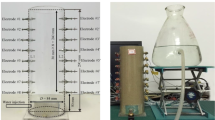Abstract
Soil samples were taken in order to investigate the spatial soil water content changes at 40 points in a field of 675 m2 located on the old Istanbul-Izmit road in Kocaeli-Turkey. The water content values of soil samples collected were obtained using oven and Speedy Moisture Tester (SMT) in the laboratory to correlate with measured electrical conductivity of soil by electrical resistivity method with a 2-electrode system. The results showed a reasonably good correlation between electrical conductivity and water content. The determination coefficient between the water content and the electrical conductivity found by the oven method (R2 ≈ 0.8) was higher than that of the SMT (R2 ≈ 0.6). The correlation between the water content values of oven and SMT is quite affordable with the determination coefficient (R2 ≈ 0.7). Considering the results obtained from Oven and SMT method, it can be concluded that the resistivity method is also successful in measuring soil water content. It is foreseen that resistivity method can be preferred both because it is easy to use, and large areas are faster and economical in measuring soil water content.









Similar content being viewed by others
REFERENCES
A. Bozkurt, C. Kurtulus, and H. Endes, “Measurements of apparent electrical conductivity and water content using a resistivity meter,” Int. J. Phys. Sci. 4 (12), 784–795 (2009).
A. Pozdnyakov, L. Pozdnyakova, and L. Karpachevskii, “Relationship between water tension and electrical resistivity in soils,” Eurasian Soil Sci. 39, S78–S83 (2006). https://doi.org/10.1134/S1064229306130138
A. A. Bery and N. E. H. Ismail, “Empirical correlation between electrical resistivity and engineering properties of soils,” Soil Mech. Found. Eng. 54 (6), 425–429 (2018). https://doi.org/10.1007/s11204-018-9491-7
B. R. Spies and R. G. Ellis, “Cross-borehole resistivity tomography of a pilot-scale, in-situ verification test,” Geophysics 60 (3), 886–898 (1995). https://doi.org/10.1190/1.1443824
D. Michot, Y. Benderitter, A. Dorigny, B. Nicoullaud, D. King, and A. Tabbagh, “Spatial and temporal monitoring of soil water content with an irrigated corn crop cover using surface electrical resistivity tomography,” Water Resour. Res. 39 (5), (2003). https://doi.org/10.1029/2002WR001581
D. A. Robinson, S. C. Campbell, J. W. Hopmans, B. K. Hornbuckle, S. B. Jones, R. Knight, F. Odgen, J. Selker, and O. Wendroth, “Soil moisture measurement for ecological and hydrological watershed-scale observatories: a review,” Vadose Zone J. 7, 359–389 (2008). https://doi.org/10.2136/vzj2007.0143
F. Garrido, M. Ghodrati, and M. Chendorain, “Small-scale measurement of soil water content using a fiber optic sensor,” Soil Sci. Soc. Am. J. 63 (6), 1505–1512 (1999). https://doi.org/10.2136/sssaj1999.6361505x
F. Ozcep, E. Yıldırım, O. Tezel, M. Asci, and S. Karabulut, “Correlation between electrical resistivity and soil-water content based artificial intelligent techniques,” Int. J. Phys. Sci. 5 (1), 47–56 (2010).
F. Ozcep, O. Tezel, and M. Asci, “Correlation between electrical resistivity and soil-water content: Istanbul and Golcuk,” Int. J. Phys. Sci. 4 (6), 362–365 (2009).
F. I. Siddiqui and S. Osman, “Integrating geo-electrical and geotechnical data for soil characterization,” Int. J. Appl. Phys. Math. 2 (2), 104 (2012). https://doi.org/10.7763/IJAPM.2012.V2.63
G. Calamita, L. Brocca, A. Perrone, and T. Moramarco, “Electrical resistivity and TDR methods for soil moisture estimation in central Italy test-sites,” J. Hydrol. 454, 101–112 (2012). https://doi.org/10.1016/j.jhydrol.2012.06.001
G. A. Leonard, Foundation Engineering (McGraw-Hill, London, 1962).
G. C. Topp, J. L. Davis, and A. P. Annan, “Electromagnetic determination of soil water content: measurements in coaxial transmission lines,” Water Resour. Res. 16 (3), 574–582 (1980). https://doi.org/10.1029/WR016i003p00574
H. Shima, “2-D and 3-D resistivity imaging reconstruction using crosshole data,” Geophysics 55 (10), 682–694 (1992). https://doi.org/10.1190/1.1443195
I. Ketin and Ö. Gümüş, Unpublished Technical Report No. 288, 118 (1963).
I. Rodríguez-Iturbe and A. Porporato, Ecohydrology of Water-Controlled Ecosystems: Soil Moisture and Plant Dynamics (Cambridge University Press, Cambridge, 2007)
J. M. Blonquist, S. B. Jones, and D. A. Robinson, “Standardizing characterization of electromagnetic water content sensors,” Vadose Zone J. 4, 1059–1069 (2005). https://doi.org/10.2136/vzj2004.0141
K. M. Larson, E. E. Small, E. D. Gutmann, A. L. Bilich, J. J. Braun, and V. U. Zavorotny, “Use of GPS receivers as a soil moisture network for water cycle studies,” Geophys. Res. Lett. 35 (24), (2008). https://doi.org/10.1029/2008GL036013
Kocaeli Province Environmental Status Report 2012 (Kocaeli Province Directorate of Environment and Urbanization, Kocaeli, 2012).
M. Zreda, D. Desilets, and T. P. Ferré, “Cosmic-ray neutron probe: non-invasive measurement of soil water content,” in Transactions of American Geophysical Union Fall Meeting 2005 (San Francisco, 2005), Abst. ID U21B-0810.
R. B. Grayson and A. W. Western, “Towards aerial estimation of soil water content from point measurements: time and space stability of mean response,” J. Hydrol. 207, 68–82 (1998). https://doi.org/10.1016/S0022-1694(98)00096-1
S. B. Jones, M. Wraith, and O. Dani, “Time domain reflectometry measurement principles and applications,” Hydrol. Process. 16 (1), 141–153 (2002). https://doi.org/10.1002/hyp.513
S. R. Evett, “Soil water measurement by neutron thermalization,” in Encyclopedia of Water Science (Marcel Dekker, New York, 2003), pp. 889–893. https://doi.org/10.1081/E-EWS120010153
S. R. Evett, L. K. Heng, P. Moutonnet, and M. L. Nguyen, Field Estimation of Soil Water Content: A Practical Guide to Methods, Instrumentation and Sensor Technology (International Atomic Energy Agency, Vienna, 2008). https://doi.org/10.2136/vzj2008.0171
W. Daily and E. Owen, “Cross-borehole resistivity tomography,” Geophysics 56 (8), 1228–1235 (1991). https://doi.org/10.1190/1.1443142
W. Nijland, M. Van der Meijde, E.A. Addink, and S.M. de Jong, “Detection of soil moisture and vegetation water abstraction in a Mediterranean natural area using electrical resistivity tomography,” Catena 81 (3), 209–216 (2010). https://doi.org/10.1016/j.catena.2010.03.005
Y. Li and D.W. Oldenburg, “Approximate inverse mappings in DC resistivity problems,” Geophys. J. Int. 109 (2), 343–362 (1992). https://doi.org/10.1111/j.1365-246X.1992.tb00101.x
Y. Son, M. Oh, and S. Lee, “Estimation of soil weathering degree using electrical resistivity,” Environ. Earth Sci. 59 (6), 1319–1326 (2010). https://doi.org/10.1007/s12665-009-0119-0
Author information
Authors and Affiliations
Corresponding author
Rights and permissions
About this article
Cite this article
Kurtuluş, C., Yeken, T. & Durdağ, D. Estimating the Soil Water Content Using Electrical Conductivity, Oven Method and Speedy Moisture Tester. Eurasian Soil Sc. 52, 1577–1582 (2019). https://doi.org/10.1134/S1064229319120081
Received:
Revised:
Accepted:
Published:
Issue Date:
DOI: https://doi.org/10.1134/S1064229319120081




